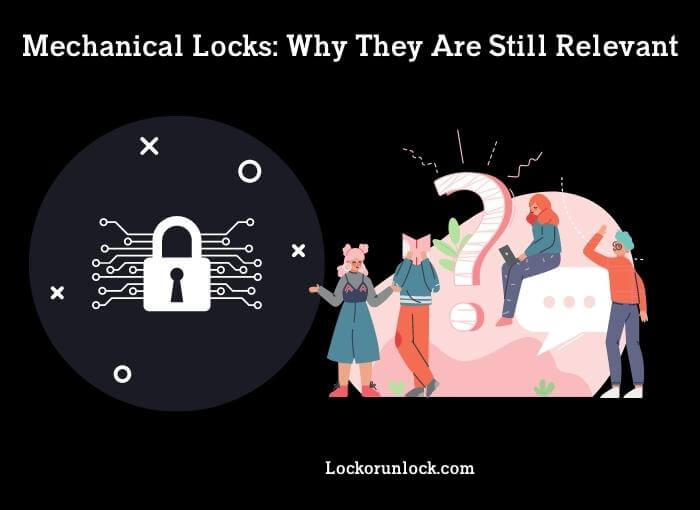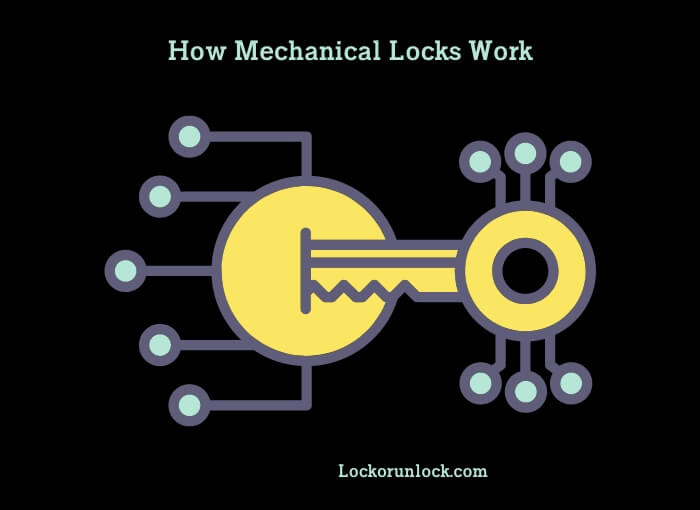Mechanical locks have been used for centuries to secure homes, offices, and other important structures. They are still one of the most popular types of locks used today, despite the rise of electronic and digital security systems. While electronic locks and keyless entry systems have gained popularity in recent years, many people still prefer the simplicity and reliability of mechanical locks.

This is because mechanical locks do not rely on batteries or electronic components, making them less prone to failure or malfunction. Mechanical locks are often more affordable than electronic locks, which can be a consideration for those on a budget.
Mechanical locks have a long history of providing security, and many people feel more comfortable with the familiarity of a traditional lock and key.
Mechanical Locks
A mechanical lock is a traditional type of lock that uses mechanical components, such as tumblers and springs, to secure a door or other entryway. Mechanical locks are operated with a physical key that is inserted into the lock and turned, causing the internal components to move and engage the locking mechanism.
Mechanical locks can come in various types, including pin tumbler locks, lever locks, wafer tumbler locks, and disc tumbler locks, each of which has a unique mechanism for securing the door. Despite the emergence of electronic and digital security systems, mechanical locks remain a popular and effective security solution for many people.
History of Mechanical Locks
Mechanical locks have been around for thousands of years, with evidence of early mechanical locks dating back to ancient Egypt and Babylon. The earliest known mechanical locks were simple wooden devices that were operated with a wooden key. Over time, locks became more complex, incorporating more sophisticated mechanisms, such as tumblers, springs, and levers.
In the 18th and 19th centuries, there was a surge in the development of mechanical locks, particularly in Europe and America. During this time, several notable inventors, including Robert Barron, Joseph Bramah, and Linus Yale Jr., developed various types of locks that are still in use today. Barron’s double-acting tumbler lock, invented in 1778, was the first lock to use a spring-loaded bolt, making it more secure than earlier locks.
Bramah’s “unpickable” lock, invented in 1784, used a complex system of levers that made it extremely difficult to pick. Yale’s cylinder lock, invented in 1861, introduced the concept of using a small, cylindrical key to rotate a plug inside the lock, which engaged the locking mechanism.
In the 20th century, mechanical locks continued to evolve, with advancements in materials, manufacturing techniques, and design. However, the rise of electronic and digital security systems in the latter half of the century posed a significant challenge to the popularity of mechanical locks.
Mechanical locks still remain a popular and effective security solution for many people, particularly in residential and commercial settings. Today, mechanical locks are available in a wide range of types, sizes, and designs, making them suitable for a variety of applications.
Importance of Mechanical Locks in Modern Society
Despite the emergence of electronic and digital security systems, mechanical locks still play an essential role in modern society. Mechanical locks offer a range of benefits that electronic and digital systems cannot match, making them a reliable and effective security solution for many people.

The main advantages of mechanical locks are their durability and reliability. Mechanical locks do not rely on batteries or electronic components, meaning that they are less prone to failure or malfunction. This makes them particularly suitable for use in harsh environments or areas with frequent power outages. Mechanical locks are often more affordable than electronic locks, making them a cost-effective option for those on a budget.
Mechanical locks are also straightforward to use and understand, requiring only a physical key to operate. This simplicity makes them ideal for use in residential and commercial settings, where multiple people may need access to a space, and the locking mechanism must be easy to use and maintain.
Mechanical locks have a long history of providing security, and many people feel more comfortable with the familiarity of a traditional lock and key. Mechanical locks can offer a higher level of security than electronic locks in certain situations. For example, some mechanical locks use multiple tumblers or levers, making them more difficult to pick or bypass than electronic locks.
Types of Mechanical Locks
Mechanical locks come in various types, each with its unique mechanism for securing a door or other entryway. Here are some of the most common types of mechanical locks:

Pin Tumbler Locks
This is the most popular type of mechanical lock, and it is widely used in residential and commercial settings. It works by using a series of pins that move up and down within the lock cylinder. The correct key lifts each pin to the correct height, allowing the cylinder to rotate and unlock the door.
Lever Locks
Lever locks are commonly used in Europe and other parts of the world. They use a series of levers that must be lifted to a specific height to unlock the door. Lever locks are considered more secure than pin tumbler locks and are commonly used in high-security applications.
Wafer Tumbler Locks
Wafer tumbler locks are commonly used in automobiles and file cabinets. They use a series of flat wafers that must be aligned in the correct position to unlock the door. Wafer tumbler locks are considered less secure than pin tumbler locks and are not commonly used for high-security applications.
Disc Tumbler Locks
Disc tumbler locks are similar to wafer tumbler locks, but they use a series of rotating discs instead of flat wafers. Each disc must be rotated to the correct position to unlock the door. Disc tumbler locks are commonly used in vending machines and other low-security applications.
Cam Locks
Cam locks are commonly used in furniture and cabinets. They use a rotating cam that engages with a strike plate to lock the door. Cam locks are considered low-security and are not commonly used for high-security applications.
Keyless Locks
Keyless locks are electronic or mechanical locking systems that allow users to lock and unlock doors without using a traditional key. Instead of a physical key, users can use a password, PIN code, swipe card, fingerprint, or Bluetooth-enabled smartphone to gain access.
How Mechanical Locks Work?
Mechanical locks work by using a series of internal mechanisms to prevent the opening of a lock without the correct key. The most common type of mechanical lock is the pin tumbler lock, which is made up of a lock cylinder and a series of pins.
Inside the lock cylinder, there are several spring-loaded pins of varying lengths. The pins are arranged in pairs, with one pin resting on top of the other. The lower pin is called the key pin, and the upper pin is called the driver pin.

When the correct key is inserted into the lock, the key’s notches align with the key pins, causing them to rise to the correct height. As the key pins rise, they push the driver pins up and out of the way, allowing the cylinder to rotate and unlock the lock.
If an incorrect key is used, the key pins will not align correctly, preventing the driver pins from being pushed up and out of the way. This will prevent the lock cylinder from rotating, keeping the lock secured.
Other types of mechanical locks, such as lever locks and disc tumbler locks, work on similar principles but use different internal mechanisms. Lever locks use a series of levers that must be lifted to a specific height to unlock the door, while disc tumbler locks use rotating discs that must be aligned to the correct position.
Advantages of Mechanical Locks
Mechanical locks offer several advantages over other types of locks, such as electronic and digital locks.
Durability
Mechanical locks are built to last and can withstand harsh conditions, making them ideal for use in outdoor settings. They are less likely to malfunction or be affected by power outages or electrical surges.
Cost-Effectiveness
Mechanical locks are generally less expensive than electronic or digital locks, making them a cost-effective option for residential and commercial use. They also require minimal maintenance and do not require a power source.
Reliability
Mechanical locks are simple in design and rely on physical components, making them less prone to malfunction or hacking. They are a reliable option for securing doors and other entryways.
Compatibility
Mechanical locks are compatible with a wide range of doors, making them a versatile option for use in various settings. They can be easily installed and replaced, and there are many different types and sizes available to meet different needs.
Security
Mechanical locks are generally considered more secure than electronic or digital locks, as they are not vulnerable to hacking or electronic interference. They also provide a physical barrier that is difficult to overcome without the correct key.
Disadvantages of Mechanical Locks
Vulnerability to Picking
Mechanical locks can be picked by skilled locksmiths or intruders, especially if they are not high-security locks. Intruders can use tools such as lock picks, bump keys, and drill bits to bypass the lock and gain entry.
Limited Access Control
Mechanical locks provide a physical barrier but do not offer sophisticated access control features. This means that once a key is given to someone, they have access until the key is returned or the lock is changed.
Key Management
Mechanical locks require careful key management to ensure that keys are not lost, stolen, or copied without authorization. Lost or stolen keys can compromise security and require costly rekeying or lock replacement.
Wear and Tear
Mechanical locks can suffer from wear and tear over time, causing keys to become stuck or the lock to malfunction. Regular maintenance and lubrication can help prevent this, but it is still a consideration.
Noise: Mechanical locks can be noisy when locked or unlocked, which can be a concern in settings where noise is a consideration.
Bottom Line
Mechanical locks have been used for centuries to provide security for homes, businesses, and other settings. While newer technologies such as electronic and digital locks have emerged in recent years, mechanical locks remain a popular and reliable option for many people.
Mechanical locks come in various types, such as pin tumbler locks, lever locks, and disc tumbler locks, each with its own set of advantages and disadvantages. They work by using internal mechanisms to prevent the opening of the lock without the correct key.
Some of the advantages of mechanical locks include durability, cost-effectiveness, reliability, compatibility, and security. They are also vulnerable to picking, have limited access control, require careful key management, suffer from wear and tear, and can be noisy.
